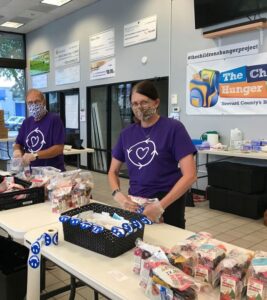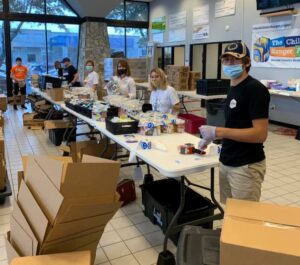Ten years ago, Bob Barnes, founder of The Children’s Hunger Project saw an unimaginable need in his Florida community. There were many Brevard County children who relied on their school lunches during the week, but when they went home for the weekend, they didn’t have food to eat. After seeing this food gap and hearing from teachers that students were coming into school hungry on Mondays, Bob Barnes decided to start The Children’s Hunger Project (TCHP).
In 2000, TCHP started feeding 27 kids at one school. Over the years the need has increased. TCHP reports, “In Brevard County, the number of children in the free and reduced-price meal program exceeds 50%. Some elementary schools have 80% or more of their kids on the free and reduced-price meal program with many of them at risk of childhood hunger and malnutrition.” To help achieve their mission, TCHP started spreading the word and creating awareness in their community while also building relationships with the schools and learning the specific need each school had. Through their efforts and community support, The Children’s Hunger Project is now supplying over 2,000 children with weekend food packages at 45 schools.
We recently caught up with TCHP Executive Director Cheryl Cominsky to see how things are going and if the COVID-19 pandemic had any impact on their organization. Thankfully, because TCHP supplies food, they were considered essential and never had to close their doors, though they did have to make some big changes to their business model. Before the pandemic, TCHP would hold weekly food packaging events every Thursday night with 30-50 volunteers packing anywhere from 1,000-2,000 food packages. But when COVID hit, they quickly had to switch gears and break up their food packing events into smaller groups scattered throughout the week, ensuring they were following the most up-to-date guidelines, including performing extra cleaning, wearing masks as well as gloves, and sanitizing between each packing event.
 Their business model wasn’t the only thing to change though. When schools moved to virtual learning, The Children’s Hunger Project learned that Brevard County was going to start mobile feedings so families could drive up and get food for their children. Cominsky said, “We decided we wanted to help out as much as we could as well. At the beginning of the pandemic there were 27 schools that were feeding children. Not just elementary school children—anyone from 0-18. We typically focused on the elementary school students. So, we went from serving 2,400 to almost 6,000 at that point because we decided to commit to delivering 200 of our weekend food packages to all 27 locations.” In addition to supporting the schools, TCHP was also helping other groups where children go to look for food, such as Brevard C.A.R.E.S. and Club Esteem, to name a few. When summer break started, TCHP continued to feed as many as they could. As Cominsky says, “That’s just what we do.”
Their business model wasn’t the only thing to change though. When schools moved to virtual learning, The Children’s Hunger Project learned that Brevard County was going to start mobile feedings so families could drive up and get food for their children. Cominsky said, “We decided we wanted to help out as much as we could as well. At the beginning of the pandemic there were 27 schools that were feeding children. Not just elementary school children—anyone from 0-18. We typically focused on the elementary school students. So, we went from serving 2,400 to almost 6,000 at that point because we decided to commit to delivering 200 of our weekend food packages to all 27 locations.” In addition to supporting the schools, TCHP was also helping other groups where children go to look for food, such as Brevard C.A.R.E.S. and Club Esteem, to name a few. When summer break started, TCHP continued to feed as many as they could. As Cominsky says, “That’s just what we do.”
When we asked Cominsky to share more about TCHP community of volunteers during the pandemic, she said they’ve “always been blessed with volunteers, but our business model changed and our need for volunteers changed as did the need for food packages every week.” With an increased need, they sometimes had 10 groups of 10 volunteers a week at different times to meet the demand for food packages. In addition to packing food, each week volunteers would come pick up food boxes and deliver them to all 27 schools, staying at the schools for about two hours to distribute food to the families.
While 2020 was a year with a lot of unique challenges, it was a year to remember for TCHP. Not only did they commemorate their 10-year anniversary, but they also had their most impactful year, supported by the outpouring of help from their community and the volunteers who helped them serve so many more kids.
 It’s not easy to imagine hunger in our own backyards, but the need is bigger than you think. Volunteering is The Children’s Hunger Project’s number-one need as all their food is packaged and delivered by volunteers. You can find their weekly volunteer needs posted on their website and Facebook page. If you would like to show monetary support, only $150 supports a child for the entire school year. That’s just $12.50 a month. Or, if you think of it this way, that’s less than $0.42 a day to provide food to a child who experiences food insecurity on the weekends.
It’s not easy to imagine hunger in our own backyards, but the need is bigger than you think. Volunteering is The Children’s Hunger Project’s number-one need as all their food is packaged and delivered by volunteers. You can find their weekly volunteer needs posted on their website and Facebook page. If you would like to show monetary support, only $150 supports a child for the entire school year. That’s just $12.50 a month. Or, if you think of it this way, that’s less than $0.42 a day to provide food to a child who experiences food insecurity on the weekends.
For the children who receive the food packages, Cominsky says, “It’s the world to them. It’s like Christmas every week.”
If you enjoy nonprofit inspiration and advice, please follow Powerhouse on Facebook. Do you have an inspirational nonprofit we should hear about or possibly highlight in a future quarterly newsletter? Get in touch with our CEO and founder, Jessica Bertsch!



